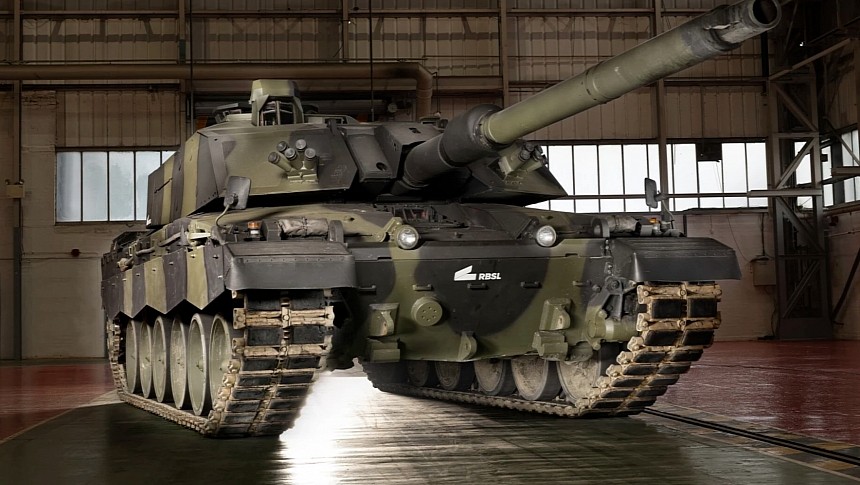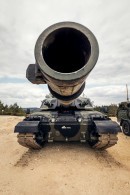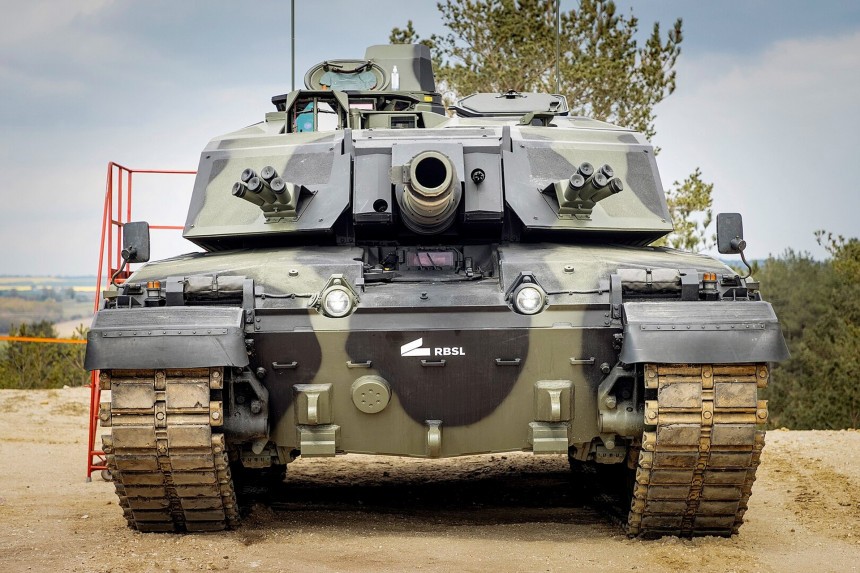Like the works of Charles Darwin or your average game of Pokémon, Main Battle Tanks are constantly evolving. As far as British MBTs are concerned, most roads tend to pass through the all-time classic Challenger series. With that in mind, feast your eyes on the admittedly unimaginatively-named Challenger 3, coming to a battlefield hopefully nowhere near you sometime in the mid-to-late 2020s.
Tank geeks the world over laud the Challenger series of tanks as some of the finest war machines to come out of Britain in the late 20th century. But, for those who aren't up to date on their British tanks, here is a brief history around the moniker. Indeed, the Challenger lineage dates back to the Second World War, with a modification of the iconic Cromwell tank dubbed the Cruiser Mk VIII Challenger. With a mighty Rolls-Royce Meteor V12 engine at its heart and a brutal Ordnance QF 17-pounder (76.2 mm) cannon on offer, only a lack of better armor prevented the first in the Challenger series from being a more well-regarded cruiser tank.
Nearly 40 years after the end of World War II, the Challenger line of main battle tanks began in earnest with the Royal Ordnance Factory FV4030 Challenger 1. A venerable bruiser of a machine that weighed a minimum of 62 tons, the Challenger 1's innovative Chobham composite armor would have been the toast of any MBT in the world had the American Abrams not worn such armor first. But regardless, the Challenger 1's 120 mm Royal Ordnance rifled cannon packed a mean punch as Iraqi T-72 crews discovered on the battlefields of the First Gulf War. Its 1,200 horsepower diesel engine allowed for an impressive top speed of 35 mph (56 km/h) to boot.
But perhaps at no time since World War II did British ingenuity show its stuff more prominently than with the Vickers Defense Systems FV4034 Challenger 2. Nearly single-handedly, the Challenger 2 prevented Great Britain from having to order American M1 Abrams to supplement its reserves of MBTs starting in the early 90s. With the same basic engine as the Challenger 1 but sporting an upgraded variant of its L11A 120 mm rifled cannon dubbed the L30, plus upgrades to its thick Chobham armor, the Challenger II could theoretically lay waste to just about any other MBT in service today.
That's why even two decades after its production run ended, Challenger 2s are high-ticket commodities actively being sent to battlefields in Ukraine to use in their campaign against Russia. But even the mighty Challenger 2 in service since 1998 can't defend the British Isles forever. Eventually, something newer or better is bound to take its place. But, as it turns out, the best thing to replace a Challenger 2 tank is an even better Challenger 2 tank. As far back as 2005, the British Ministry of Defense had been mulling over programs to extend the service life of the Challenger 2 well into the 2030s and possibly even beyond.
Key areas which the MoD required to be improved include better target acquisition capability for the tank's commander and gunner, as well as upgrades to the Challenger II's hydrogas suspension and its Perkins CV12 turbodiesel engine. Upgrades to the Challenger II's armor were perhaps the most pressing matter on the docket for Britain's MBT. Novel means of active and passive anti-ballistics systems like the Rheinmetall ROSY smoke-based Rapid Obscurant System and Multifunctional Self protection System (MUSS) active protection systems were all points of consideration as the upgrade path for the Challenger 2 became clear.
Several different military contractors were called upon to present proposals for a Challenger II upgrade solution, including the UK-based operations of American companies like Lockheed Martin and General Dynamics. But it was the combined team of the British BAE Systems and the German company Rheinmetall who pooled their recourses together to create a Challenger 2 upgrade path worthy of being a bespoke successor to this historic lineage. Dubbed the Challenger 3, this novel tank design admittedly shares a chassis with the Challenger 2. But where things start to get interesting isn't necessarily this tank's internals but rather its main armament.
Breaking the tradition of Challenger tanks carrying rifled main cannons with its third iteration was undoubtedly a controversial decision. But looking at the Rheinmetall L55A1 120 mm smoothbore gun used in Challenger 3 tech demos, you can at least see the logic behind this decision. This cannon traces its lineage back to the L55 smoothbore cannon used on the Leopard 2A6/A7 family and therefore shares a wide degree of ammunition commonality with contemporary NATO tanks from other member nations like France, Germany, and the US. Complete with a sophisticated thermal imaging and target tracking system for both the tank's commander and gunner, there's little opposing Russian MBTs can do if a Challenger 3 lines them up in its sights.
Even if an enemy vehicle identifies and fires at a Challenger 3, its sophisticated laser-based warning system and upgraded main hull armor make for a tank that's very difficult to knock out. An optional electronic active protection system first trialed on the BAE Systems Challenger 2 Black Night upgrade package before their merger with Rheinmetall actively works to defeat incoming radar or infrared-guided ballistics fired at the tank if all else fails. Meanwhile, upgrades under the hood, like common-rail fuel injection for the tank's Perkins V12 engine, combined with the latest third-generation adjustable hydrogas suspension and improved transmission and engine cooling systems, make for a tank as quick and reliable as it is deadly accurate in combat. Admittedly, this engine upgrade won't add extra horsepower to the 1,200 figure of the Challenger 2. But, extra reliability is always a plus.
On paper, at least, all these enhancements to the basic Challenger 2 chassis make for a vehicle at least on par with contemporary NATO offerings like the M1A2 SEP and the Leopard 2PL. Compared to largely unproven Russian tanks like the T-14 Armata, there's a strong argument that the Challenger 3 exceeds the abilities of its rivals by a not unsubstantial degree. But alas, this doesn't mean the Challenger 3's development has been free of blemishes or controversy. When presented with BAE/Rheinmetall's design proposal in 2021, several members of the British Parliament commented that British tank designs might be "outgunned" by Russian tanks in a hypothetical combat scenario.
That said, the woeful performance of Russian tanks in their subsequent Invasion of Ukraine brings this line of thinking very much into doubt. Further complaints came from a March 2021 meeting of the British Defense Select Committee. As a result of this meeting, a report was published on the website of the British Parliament stating, "Despite having spent around 50% of the allocated budget (£800 million), the program has yet to place a manufacturing contract. The program has a current in-service date of 2024 (originally planned for 2017) and is some £227 million over budget. After a decade of effort, this abject failure to deliver against both cost (with an overrun now totaling over a quarter of a billion pounds of public money) and timescale (ISD seven years late) is clearly totally unacceptable."
In spite of all the controversy, the Challenger 3 is still slated to enter full-scale production once initial ground tests have concluded sometime between 2027 and 2030. Meanwhile, the Russians continue to be bedeviled with problems manufacturing their counter to the Challenger 3, the T-14 Armata. With only a handful of T-14 prototypes manufactured in light of the War in Ukraine and only slightly more T90Ms, it's not a guarantee that Russia could amass a fleet of ultra-modern MBTs before the Challenger 3 is ready for mass production. Meanwhile, shipments of Challenger 2s have already made their way over to Ukraine to fight in this same conflict. Here's to hoping this war is done and dusted before the Challenger 3's development is finished, lest they also have to be shipped to the front line to join its predecessors in combat against Russia.
Nearly 40 years after the end of World War II, the Challenger line of main battle tanks began in earnest with the Royal Ordnance Factory FV4030 Challenger 1. A venerable bruiser of a machine that weighed a minimum of 62 tons, the Challenger 1's innovative Chobham composite armor would have been the toast of any MBT in the world had the American Abrams not worn such armor first. But regardless, the Challenger 1's 120 mm Royal Ordnance rifled cannon packed a mean punch as Iraqi T-72 crews discovered on the battlefields of the First Gulf War. Its 1,200 horsepower diesel engine allowed for an impressive top speed of 35 mph (56 km/h) to boot.
But perhaps at no time since World War II did British ingenuity show its stuff more prominently than with the Vickers Defense Systems FV4034 Challenger 2. Nearly single-handedly, the Challenger 2 prevented Great Britain from having to order American M1 Abrams to supplement its reserves of MBTs starting in the early 90s. With the same basic engine as the Challenger 1 but sporting an upgraded variant of its L11A 120 mm rifled cannon dubbed the L30, plus upgrades to its thick Chobham armor, the Challenger II could theoretically lay waste to just about any other MBT in service today.
That's why even two decades after its production run ended, Challenger 2s are high-ticket commodities actively being sent to battlefields in Ukraine to use in their campaign against Russia. But even the mighty Challenger 2 in service since 1998 can't defend the British Isles forever. Eventually, something newer or better is bound to take its place. But, as it turns out, the best thing to replace a Challenger 2 tank is an even better Challenger 2 tank. As far back as 2005, the British Ministry of Defense had been mulling over programs to extend the service life of the Challenger 2 well into the 2030s and possibly even beyond.
Several different military contractors were called upon to present proposals for a Challenger II upgrade solution, including the UK-based operations of American companies like Lockheed Martin and General Dynamics. But it was the combined team of the British BAE Systems and the German company Rheinmetall who pooled their recourses together to create a Challenger 2 upgrade path worthy of being a bespoke successor to this historic lineage. Dubbed the Challenger 3, this novel tank design admittedly shares a chassis with the Challenger 2. But where things start to get interesting isn't necessarily this tank's internals but rather its main armament.
Breaking the tradition of Challenger tanks carrying rifled main cannons with its third iteration was undoubtedly a controversial decision. But looking at the Rheinmetall L55A1 120 mm smoothbore gun used in Challenger 3 tech demos, you can at least see the logic behind this decision. This cannon traces its lineage back to the L55 smoothbore cannon used on the Leopard 2A6/A7 family and therefore shares a wide degree of ammunition commonality with contemporary NATO tanks from other member nations like France, Germany, and the US. Complete with a sophisticated thermal imaging and target tracking system for both the tank's commander and gunner, there's little opposing Russian MBTs can do if a Challenger 3 lines them up in its sights.
Even if an enemy vehicle identifies and fires at a Challenger 3, its sophisticated laser-based warning system and upgraded main hull armor make for a tank that's very difficult to knock out. An optional electronic active protection system first trialed on the BAE Systems Challenger 2 Black Night upgrade package before their merger with Rheinmetall actively works to defeat incoming radar or infrared-guided ballistics fired at the tank if all else fails. Meanwhile, upgrades under the hood, like common-rail fuel injection for the tank's Perkins V12 engine, combined with the latest third-generation adjustable hydrogas suspension and improved transmission and engine cooling systems, make for a tank as quick and reliable as it is deadly accurate in combat. Admittedly, this engine upgrade won't add extra horsepower to the 1,200 figure of the Challenger 2. But, extra reliability is always a plus.
That said, the woeful performance of Russian tanks in their subsequent Invasion of Ukraine brings this line of thinking very much into doubt. Further complaints came from a March 2021 meeting of the British Defense Select Committee. As a result of this meeting, a report was published on the website of the British Parliament stating, "Despite having spent around 50% of the allocated budget (£800 million), the program has yet to place a manufacturing contract. The program has a current in-service date of 2024 (originally planned for 2017) and is some £227 million over budget. After a decade of effort, this abject failure to deliver against both cost (with an overrun now totaling over a quarter of a billion pounds of public money) and timescale (ISD seven years late) is clearly totally unacceptable."
In spite of all the controversy, the Challenger 3 is still slated to enter full-scale production once initial ground tests have concluded sometime between 2027 and 2030. Meanwhile, the Russians continue to be bedeviled with problems manufacturing their counter to the Challenger 3, the T-14 Armata. With only a handful of T-14 prototypes manufactured in light of the War in Ukraine and only slightly more T90Ms, it's not a guarantee that Russia could amass a fleet of ultra-modern MBTs before the Challenger 3 is ready for mass production. Meanwhile, shipments of Challenger 2s have already made their way over to Ukraine to fight in this same conflict. Here's to hoping this war is done and dusted before the Challenger 3's development is finished, lest they also have to be shipped to the front line to join its predecessors in combat against Russia.









